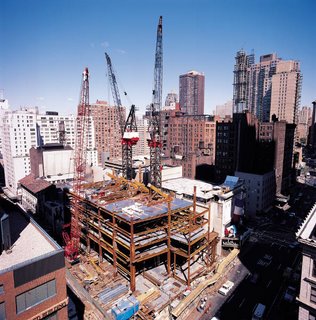
After another successful holiday season, where we've collected and given piles of loot to one another, it seems as good a time as any to reflect on this acquisitive culture in which we find ourselves. The spark that brought me to this topic was a wholesome story my fiance and I picked up on a Toronto talk show a few days before Christmas as we drove along the New York Thruway. As they explained to the enthralled host, a couple who had lived many years in the bustle of Toronto decided to pick up their belongings, leave their families and head for the "great north" in Yellowknife, Northwest Territories. Despite the remote nature of the settlement, the husband and wife team expressed no regrets for their decision. She took a job to study the thawing permafrost in the area, and he seemed to have a lot of extra time on hand to pursue his hobbies. She touted her five-minute commute, by foot, to the office -- ten if she stopped to window shop. He lamented the brief visit back to the "big city," and yearned for a speedy return back to his new utopia.
The quaint Canadian couple, along with our cross-country travels a few weeks before, got me thinking about America's urban-oriented mentality, and how most of us (since most of us live in cities and suburbs) will never know what it's truly like to live the "rural way of life." Sure, new developments on the urban fringe attempt to recreate this existence by incorporating the natural environment, be it prairie or forest land, into the residential and commercial structures that rise from the soil. Names of new places evoke what had to be removed to permit us to move in. But living in Yellowknife is still very different from buying into a new townhouse development in central New Jersey.
This divergence in lifestyle choice is clear, but it is not the end of the story. As mentioned last time, no matter how sleepy or "empty" their environs, Americans have learned to make productive use of property, even if it does not have skyscrapers rising above the surface, and subways running below it. If people are present, electric lines must be strung, roads must be built, and septic tanks must be dug. Residents must have a source of water, and they inevitably produce a stream of refuse that must find a home separate from the settlement. Even pastoral farms must have irrigation systems and gas-powered machinery to plant and harvest their products. There may be less people populating rural expanses, but there are people there nonetheless. The consumption of materials, resulting in waste products, is, at its most mundane level, the human condition.
So when that couple from Yellowknife recounts life in that "slower" part of the world, it's hard to overlook the fact that they enjoy many of the same "necessities" of modern human life, down to their satellite cable keeping them connected to what's happening to the South. Land use is land use, be it in midtown Manhattan or the Northwest Territories. There may be less people in their humble settlement, but the consumption mentality remains, down to the Yellowknife couple's window shopping on the way to work. And in this season where we try to find common bonds that unite us all, land use, oddly enough, is one of those connections. The universality of the land use process, which is how we decide to organize our settlements, makes it a common question for all of us stationed on this planet, wherever that might be. This is perhaps not the most heart-warming sentiment for the season, but, take a drive down the street you live on and see the garbage bag upon garbage bag of wrapping paper after Christmas. Viewing such a spectacle shows that it is the day-to-day realities of our existence that ties us tightly together, and brings us together to live in towns and cities strewn across the continent.











